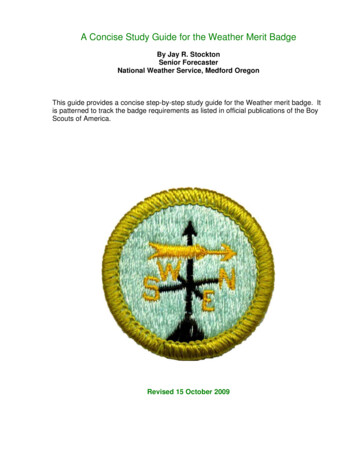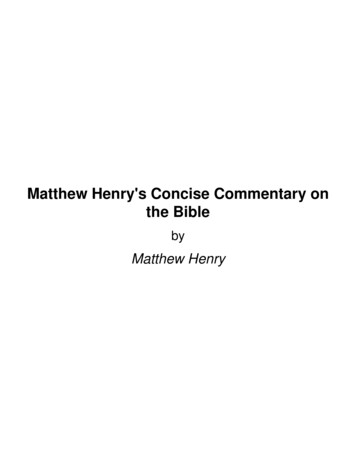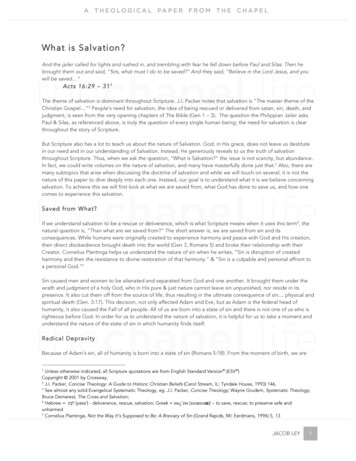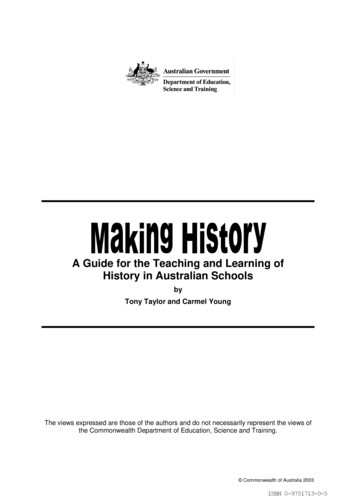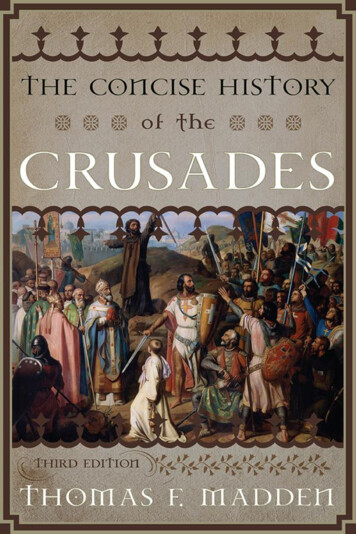
Transcription
The Concise Historyof the Crusades
The Concise Historyof the CrusadesThird EditionThomas F. MaddenROWMAN & LITTLEFIELDLanham Boulder New York Toronto Plymouth, UK
Published by Rowman & Littlefield4501 Forbes Boulevard, Suite 200, Lanham, Maryland 20706www.rowman.com10 Thornbury Road, Plymouth PL6 7PP, United KingdomDistributed by National Book NetworkCopyright 1999, 2006, 2013, 2014 by Rowman & LittlefieldAll rights reserved. No part of this book may be reproduced in any form or by anyelectronic or mechanical means, including information storage and retrieval systems,without written permission from the publisher, except by a reviewer who may quotepassages in a review.British Library Cataloguing in Publication Information AvailableLibrary of Congress Cataloging-in-Publication DataThe concise history of the crusades / Thomas F. Madden. — Third Edition.pages cm. — (Critical issues in world and international history)Includes bibliographical references and index.1. Crusades. I. Title.D157.M33 2013909.07—dc232013008138ISBN: 978-1-4422-1574-0 (cloth : alk. paper)ISBN: 978-1-4422-3116-0 (electronic) The paper used in this publication meets the minimum requirements ofAmerican National Standard for Information Sciences—Permanence of Paperfor Printed Library Materials, ANSI/NISO Z39.48-1992.Printed in the United States of America
ContentsList of MapsPrefacevivii1 The Call2 The First Crusade3 The Rise of the Latin Kingdom of Jerusalem and the45678910Second CrusadeThe Decline of the Latin Kingdom of Jerusalem and theThird CrusadeThe Fourth CrusadeCrusading at HomeThe Fifth Crusade and the Crusade of Frederick IIThe Crusades of St. LouisThe Later CrusadesThe Legacy of the CrusadesConclusionGlossarySelect BibliographySources in TranslationIndexAbout the 3 158 Madden.indb v8/13/13 5:46 AM
1 ChapterMapsTitleThe Mediterranean world about AD 1000The First Crusade, 1095–1099The Near East after the First Crusade, 1099–1144The Second Crusade, 1146–1148The Near East after the Second Crusade, 1144–1174The Near East after the Conquests of Saladin, 1187–1190The Third Crusade, 1188–1192The Fourth Crusade, 1201–1204Constantinople at the time of the Fourth CrusadeLanguedoc at the time of the Albigensian CrusadeThe Fifth Crusade, 1218–1221The Crusades of St. LouisSt. Louis in Egypt, 1249–1250Crusade Plan of Maximilian I, 1518xii14345160737892103118134154159190vi13 158 Madden.indb vi8/13/13 5:46 AM
PrefaceW hen the first edition of this book appeared in 1999 the world was adifferent place. Then, the crusades were a faraway concept, an odd series ofevents in a distant and murky medieval past. Wars of religion seemed largelyirrelevant to citizens of a modern secular civilization. That changed. Terrorist attacks in the United States on September 11, 2001, and subsequently inEurope and the Middle East reminded us all that there remain people in theworld willing to kill or to be killed for their religion. Since then radical Muslims, known as Islamists, have continued to call on their coreligionists to takepart in a worldwide jihad against the people of the West, whom the Islamistsoften refer to as “crusaders.”For their part, many in the West worry that their actions actually do resemble those of the medieval crusaders. Significant American and Europeanmilitary forces, for example, remain stationed in the Middle East. And Israel,which enjoys significant Western support, is planted on soil that was once themedieval crusaders’ kingdom. Western diplomats and politicians are careful toavoid any mention of the medieval crusades around Muslim leaders, lest theyappear insensitive or conjure up memories of the harm done by the medievalholy wars against them. Unfortunately, these sentiments and approaches are fueled on both sides by an extremely weak understanding of the actual crusades orthe medieval world in which they flourished. As a result, decisions—sometimestragic decisions—are made based on deeply flawed concepts of history. By explaining just what the crusades were and were not, this book is an attempt toilluminate the complex relationship of the past to the present.Despite a modern groundswell of interest, the crusades remain today oneof the most commonly misunderstood events in Western history. That factis all the more lamentable given the extraordinary amount of research thatvii13 158 Madden.indb vii8/13/13 5:46 AM
viiiPrefacehas been conducted on the subject during the past sixty years. Scholars knowmuch more about the crusades today than ever before. However, most of thatresearch is highly technical in nature and presented, appropriately enough, inscholarly journals and monographs that can seem impenetrable to those without specialized training. When the first edition of this book was publishedit joined only two other single-volume histories of the crusades written byprofessional historians—and even those two assumed a fair level of knowledge regarding medieval history. Back then an interested person who simplystrolled into a bookstore looking for a history of the crusades was more likelyto walk out with a book by a novelist, journalist, or ex-nun than one writtenwith care by a scholar and based on the best research available.The heightened public interest in the crusades after 9/11 created a strongmarket for new general histories, and popular authors did not disappoint. Yetmany of those new works simply retold myths long ago dispelled by professional historians. It took several years before additional crusade specialists responded to the public demand. But that trickle soon became a torrent. Todaythere are so many histories of the crusades by scholars that they are in dangerof depleting the supply of innovative names to place on their covers. Each hasits own strengths and weaknesses. Yet despite the avalanche of new studies,the fundamental purpose of this book has not changed since 1999. It aims totell the story of the crusades in a concise, understandable, and engaging manner based on the extraordinary fruits of more than half a century of modernscholarship.Any historian who seeks to explain the crusades must first make peacewith the length, breadth, and complexity of the subject. What were the crusades? When did they begin, and when did they end? What were the important milestones of the movement? Who was a crusader, and who was not?Traditionally, authors have defined the scope of the crusades in termsof the expeditions to the Holy Land. In this, they followed the structure ofmedieval sources like the Gesta Dei per Francos. The crusades, therefore, begin with Pope Urban II’s call to arms at the Council of Clermont in 1095.The twin poles of such studies are the major expeditions to the East (i.e., the“numbered” crusades) and the history of the crusader states in Syria and Palestine. The narrative thread then weaves itself between conditions in the Levantand conditions in Europe, bringing the two together in the events of thegreater crusades. From this perspective, the crusades come to a close with theextinction of the mainland crusader states in 1291. The movement, therefore,is nicely packaged in an organized fashion and in the space of two centuries.In the past few decades, this construction of the crusades has been largelyabandoned by scholars. Although traditional histories included events like theAlbigensian Crusade or Baltic Crusades, neither of which was bound for the13 158 Madden.indb viii8/13/13 5:46 AM
PrefaceixEast, they did so only peripherally. Modern scholarship has rehabilitated thisperiphery. Most historians now accept that crusading took on many differentforms; the general passage to the Holy Land was but one of them. Crusadesagainst pagans, heretics, and enemies of the church were just as common bythe thirteenth century as wars against the lands of Islam. Much of Europe’scrusading energy was also devoted to removing Muslims from Spain.Beyond broadening the definition of the crusades, scholars have also reassessed the neat organization of the major expeditions. The simplicity of thenumbered crusades gives the impression that Europe periodically explodedwith crusading zeal, sending large armies east to fight the Muslims of Palestine.Yet the crusades were not discrete campaigns but continuous streams of armieson the march. Between the major crusades were countless smaller expeditionsheading to a variety of targets.If one accepts that the crusading movement transcends the conquestof the Holy Land, then there is no reason its history should abruptly end in1291. During the past century, much research has been done on these “latercrusades.” There is no doubt that crusading remained an important part of European thought well into the Renaissance and even beyond into the ProtestantReformation and Catholic Counter-Reformation. At some point, though, thehistorian must accept that the trail has grown cold and that crusade rhetoric hasbecome merely that. If one insisted that the history of the crusades continueduntil the last crusader institution crumbled, then it would have to continueuntil the present so as to include the modern history of the Knights of Malta.Without a clear stopping point, it is up to the student to judge when the crusades ceased to be religious wars and transformed themselves into secular warswith religious trappings.Despite the explosion in crusade studies over the past sixty years, thetraditional construction of the crusades as a set of expeditions launched between 1095 and 1291 remains popular. There are good reasons for this. Thetraditional view introduces the student to the crusades in a way that is easier tograsp but does not distort the fundamental character of the movement. Whenone has a firm understanding of the crusades’ peaks, one can then better descend into the foggy crevices of their valleys. For the interested student, thatwill require reading many more books than just one general survey.For this concise history of the crusades, I follow in many respects theconstruction, if not the scope, of the traditional histories. The crusades are firstand foremost an aspect of European history. At the time few Muslims in theMiddle East understood the crusades at all. For western Europeans the crusadeswere epic struggles that helped to fashion their image of themselves and theirplace in the larger world. For Muslims the crusades were hardly worthy ofattention. As late as the seventeenth century the crusades remained virtually13 158 Madden.indb ix8/13/13 5:46 AM
xPrefaceunknown in the Muslim world. From the grand perspective of Muslim history, they were simply tiny and futile attempts to halt the expansion of Islam.For that reason my overriding objective here is to relate the history of thecrusades in a way that focuses on the events most important to Europeans atthe time. Although political crusades and crusades against heretics were heldto be valid, they were generally seen as variations on the theme of the Eastern crusades. The crusade, first and foremost, was a war against Muslims forthe defense of the Christian faith and people; therefore, although I devote achapter to crusading at home, the overall focus of this book is decidedly onthe foreign expeditions. I do not deny the validity of scholarly arguments thatwould bring other crusades to share the center stage, but I think that this canbe done only when one has a solid grasp of the original intent of the holy wars.In other respects, I part company with the traditional construction ofthe crusades. Because my concern is the crusades as an element in medievalEuropean history, I describe the history of the crusader states only insofar asthey make the crusades themselves more intelligible. The history of the LatinEast is fascinating but long and complex, and not all of it is relevant to themajor expeditions. I also extend my treatment of the crusades well beyond thefall of Acre in 1291. Although the Holy Land was lost, it was not forgottenin Europe. After 1291, many crusades were planned, and some launched, togo to the aid of Palestine. Although by the fourteenth century turning backthe Ottoman threat replaced the capture of Jerusalem as the primary motiveof crusades, crusading remained a ubiquitous part of European thought andculture. I therefore follow the later history of the crusades until the point that(it seems to me) the Europeans themselves lost interest in them.In summary, I have attempted to craft a history of the crusades that chartsa middle course between the traditional and revisionist constructions. Thereis, after all, no contradiction between the two approaches: Both are merelydifferent ways of understanding a complex set of events spanning centuries ofMediterranean history. In any general history, much of the story must be leftout. It is my hope that readers will be sufficiently intrigued by the crusades todiscover the rest for themselves.Thomas F. MaddenSaint Louis, Missouri13 158 Madden.indb x8/13/13 5:46 AM
The Concise Historyof the Crusades13 158 Madden.indb xi8/13/13 5:46 AM
13 158 Madden.indb xii8/13/13 5:46 AM
1 The CallThe modern word “crusade” derives from cruce signati (“those signed bythe cross”), a descriptive term used occasionally after the twelfth centuryto refer to crusaders. Today, the term is commonly used to denote a grandenterprise, often with a moral dimension, as in General Eisenhower’s “Crusade in Europe” or a “crusade for adult literacy.” When the crusades of theMiddle Ages are remembered at all, it is usually with derision. In a postEnlightenment world, the concept of religious warfare is odious, largelybecause most people no longer believe that one’s religious beliefs are relevant to one’s view of the world. Traditionally, modern wars are fought forpolitical and ideological causes, like democracy or nationalism—ideas thatwould not seem worth the shedding of one drop of blood to most medievalmen and women. It was only in the aftermath of September 11, 2001, thatwesterners discovered that religion remains a reason to wage deadly war.But war has not changed much in nine hundred years, only its weapons andtactics. Rather than fighting for a patriotic vision of a nation-state, thousandsof medieval Europeans marched off to fight for Christ. In both cases, thesoldiers felt similarly about their causes. They were willing to sacrifice theirlives to defend what they held most sacred.HOLY WARUnlike Islam, Christianity had no well-defined concept of holy war beforethe Middle Ages. Christ had no armies at his disposal, nor did his early followers. Only in AD 312, after the conversion to Christianity of the Roman113 158 Madden.indb 18/13/13 5:46 AM
2A Concise History of the Crusadesemperor Constantine I (306–337), did the religion come into direct contactwith statecraft and warfare. Within a century, Christianity and the RomanEmpire were fused tightly together. Christians in government found themselves faced with questions of life and death, war and peace—questions thattheir religion had not wrestled with before. In the fifth century, St. Augustine outlined the necessary conditions for a Christian leader to wage a justwar, but he was quick to insist that the faithful not engage in wars of religious conversion or for the purpose of destroying heresies or killing pagans.Warfare was a necessary evil sometimes forced upon a good leader—it wasnot to be a tool of the church.The collapse of Roman power in the western Mediterranean did notspell a similar loss of power for Christianity because the Germanic barbarianswho carved up the Western empire were themselves Christians. The Christianfaith, therefore, remained the faith of the large majority of people throughoutEurope, the Near East, and North Africa.Christianity’s first serious competitor did not arise until the seventhcentury, when the prosperous Arab merchant Mohammed founded a newreligion. Islam, or “submission to the will of God,” was and is a scrupulouslymonotheistic faith. Muslims believe that the God of the Jews and Christiansmade his word known to Mohammed, who then “recited” what he had beentold. All these prophecies were carefully preserved and later written down inthe Koran. Mohammed noted that God had frequently spoken to his peoplethrough the prophets of the Old Testament, but time and again the Jews hadignored these holy men. Mohammed accepted Jesus as a blessed prophet whowas fundamentally misunderstood by both Jews and Christians: the formerpersecuted him, and the latter proclaimed him God. Mohammed and his followers believed that God now bestowed his infallible word on a new people.Those who embraced the humble life of submission, good works, and prayerthat the Koran enjoined would enjoy the riches of heaven for eternity afterdeath.Mohammed began his prophecies and preaching in Mecca, a trading cityin Arabia. In 622, he moved to nearby Medina and became that city’s ruler.There, Mohammed inspired more than just a religion. Because the Prophetwas both a political and religious leader, Islam was at once a faith and a meansof government. Commerce, justice, diplomacy, and war were built into thebedrock of the religion. Unlike Christian leaders, who tried to reconcile theirprestige, power, and wealth with Christ’s life of poverty, Muslims had in theirfounder a model of a worldly and a spiritual leader. Mohammed waged war,first against other Arab towns and then against Mecca itself. Muslims calledeach of these wars a jihad, or “struggle.” Soldiers who died in a jihad were13 158 Madden.indb 28/13/13 5:46 AM
The Call3thought to be martyrs of the faith. At the moment of their deaths, Muslimsbelieved, the fallen in a jihad rose instantly from the sands of battle to theirreward in a lush and sensual paradise. Yet not every war was a jihad. It couldonly be waged against unbelievers, those who refused to accept the one God,and those who sought to harm Islam. Jews and Christians, from the Muslimpoint of view, worshiped the true God, failing only to accept the prophecy ofMohammed. For that reason, they were misguided, but they were not pagans.They were the “People of the Book,” who should remain free to retain theirreligious practices in the lands conquered by Islam. If they actively persecutedor hindered the advance of Islam, however, they too were legitimate targetsof jihad.After the conquest of Arabia, Mohammed envisioned the continuedexpansion of Islam. Indeed, expansionism working hand in hand with jihadbecame an important component in the Muslim worldview. Traditional Islamic thought divided the world into two spheres, the Dar al-Islam (Abodeof Islam) and the Dar al-Harb (Abode of War). The Dar al-Islam consistedof those lands directly ruled by Muslims and subject to Islamic law. The Daral-Harb, which included the Christian world, was the place in which Muslimswere enjoined to wage jihad against unbelievers, capturing their lands and subjecting their peoples. In this way it was believed that the Dar al-Harb wouldshrink and the Dar al-Islam would correspondingly increase until it coveredthe entire world.The rapid expansion of Islam was truly remarkable. After Mohammed’sdeath in 632 a series of caliphs (successors) waged energetic jihads againstneighboring peoples. Within a century, Arab Muslims had conquered Persia,Egypt, and Syria. Such rapid expansion led to rifts within the faith itself. Themost important and long-lasting of these, the division between Sunni andShia, occurred in the late seventh century. The original split was the result ofa succession dispute, but the two groups soon began to drift apart theologically as well. The minority Shi’ites looked to their imams, who led them andattained for them the esoteric truths of the Koran. The majority Sunnites insisted on the political and religious unity of the Islamic state and rejected theleadership of the imams.It would be too strong to say that it was the idea of jihad that led toChristianity’s own concept of holy war. The Christians of the eastern RomanEmpire, known to historians as the Byzantine Empire, were willing enoughto flirt with the idea of holy war during Emperor Heraclius’s (610–641) campaigns against the Persians. When the forces of Islam exploded onto Byzantinelands shortly thereafter, however, the idea did not resurface. Christians weretoo fragmented into opposing sects to organize around such a fundamentally13 158 Madden.indb 38/13/13 5:46 AM
4A Concise History of the Crusadescentral doctrine. For minority Christian sects in Syria and Egypt, the arrivalof Muslims was actually good news. The new Arab leaders allowed them afreedom of worship that the emperor in Constantinople did not. Despite theirclose proximity to Islamic kingdoms, Byzantine Christians, it appears, neverdeveloped a religious rationale for waging or condoning holy war.It was in western Europe that the concept of Christian holy war tookroot and grew. Muslim conquerors who swept through all of ChristianNorth Africa also crossed the Strait of Gibraltar and established their ruleover Spain. By the eighth century, Muslim expeditionary forces were crossing the Pyrenees and marching into the heart of Catholic Europe. In 732,at the famous Battle of Tours, Frankish leader Charles Martel defeated theMuslims, driving them back into Spain. Spain was still Christendom, however, and Europeans believed strongly that Muslims should not be there.From their perspective, these lands were consecrated to Christ. It was notright that infidels should dwell there, let alone rule. Was it not self-evidentthat a Christian who fought to reclaim lands conquered by unbelievers washimself fighting for Christ? Thus, it was in dealing with the Muslim presence in Spain that Western soldiers and theologians first cut their teeth onthe idea of holy war. The Reconquista, or “reconquest,” was the trainingground for the theological and moral justification of the crusading movement. Like the later crusades, the Reconquista joined military campaignswith holy pilgrimage.In the ninth century, in a thin strip of Christian-held territory in northern Spain, the bones of St. James the Greater were discovered at Santiago deCompostello. The cult of St. James flourished in Europe, and the shrine became a rallying point for warriors who were spurred to liberate the lands theybelieved the apostle had claimed for Christ. During the first centuries of theReconquista, the church promoted the war as a just and appropriate reactionto Muslim aggression but did not articulate the kind of spiritual benefits thatwould signify a holy war.TURKISH CONQUESTSLike the Reconquista, the crusades began as a result of a Muslim conquestof Christian territories. The Byzantine Empire had lost much in the stormof Muslim expansion but emerged with its most important regions intact—namely, Greece and Asia Minor. The latter was essential for the recruitment ofsoldiers and the production of food to feed the great capital city of Constantinople. In the eleventh century, a new group, the Seljuk Turks, threatened13 158 Madden.indb 48/13/13 5:46 AM
The Call5Byzantium. The Seljuks were Muslims but not Arabs. They had swept into theregion early in the century, conquering Armenia, Syria, and Palestine. Becausethey were themselves split into antagonistic factions, they disrupted the peaceof the Near East that had been established by the Arabs. After their conquestof Jerusalem, many of the Turks were amazed to find Christian churchesand monasteries flourishing in Muslim lands. They destroyed some churches,murdered clergy, and seized pilgrims. It was not long, though, before the newconquerors learned what the Arabs had long known: Jerusalem was profitableonly by virtue of its pilgrims. Great sums of money poured into the city fromthe pockets of Christian penitents eager to pray at the holy shrines. Soon theTurkish conquerors halted direct persecutions; nevertheless, the multiplicityof petty rulers and the relative instability of the region made pilgrimage to theHoly Land a difficult and often deadly task.In 1071, Emperor Romanus IV (1068–71) arrayed his forces againstthe Turkish assault on Asia Minor at the Battle of Manzikert. The Turksdestroyed the Byzantine armies and captured the emperor. Beyond thebody-strewn battlefield, the rich plains of Anatolia lay almost defenseless,and it took the Turks only a short time to capture them. Within a few years,the citizens of Constantinople could look across the Bosporus and see theland of the Turks. And the Turks were not the only enemies closing in onthem. From the north, the Pechenegs were pressing south, and in the west,the Normans had ousted Byzantine troops from their last foothold in Italy.Many feared that the long-lived Roman Empire had finally reached its end.But, as so often occurred in Byzantine history, just as events seemed hopeless a powerful emperor came to the throne to turn the situation around.Alexius I Comnenus (1081–1118) rallied Byzantine spirits and raised alarge mercenary army to defend against the external threats. He also considered turning to the West for help. This was an action not lightly taken.Byzantines viewed all of western Europe as Roman territory temporarilyoccupied by barbarians. Although westerners were Christian, from theByzantine perspective they were misguided by various liturgical errors andheretical beliefs, chief of which was their insistence on the central authorityof the pope over all Christians. Yet Alexius needed troops, and there werea good number of them in Europe.POPE GREGORY VIIByzantium’s plight was already well known in the West. Pope Gregory VII(1073–85) had made serious plans to raise an army against the Turks as early13 158 Madden.indb 58/13/13 5:46 AM
6A Concise History of the Crusadesas 1074. For the pope, there was much to commend such a venture. In theaftermath of the Viking, Hungarian, and Islamic invasions of the ninth andtenth centuries, western Europe had become in many respects an armed camp.Fortified castles dotted the landscape. Armed knights and trained infantrywere everywhere. Kings had almost no control over most of their vassals andtherefore could claim sovereignty over only a small portion of their kingdoms.With no central authority and a proliferation of warriors, it is not surprisingthat the level of violence rose dramatically. Pitched battles and castle siegeswere bad enough, but combatants were not above destroying villages and killing women and children. The church had attempted to reduce the violencewith various initiatives, but none met with much success. The Peace of Godmovement threatened divine sanctions against those who attacked noncombatants, and the Truce of God attempted to put a stop to warfare on Sundays andholy days. The church, however, like the kings of Europe, had little controlover petty knights and landed barons.Gregory VII saw the Byzantine plight as the perfect opportunity toemploy Europe’s warriors in the service of God. When he envisioned themighty army that he hoped would march to the East, he saw himself at itshead. This fit well with the church’s evolving view of its role in secular lifeduring the eleventh-century reform movement. Reformers like Humbert ofSilva Candida and Gregory himself had long argued that for the church torid itself of sinful clerical abuses, it must first be free from the stain of laycontrol. Kings and emperors were ordained by God to look after the material needs of their people, but it was the pope and the church that had thegreater responsibility for the care of the souls of Christendom. In the finalanalysis, these reformers maintained, it was the pope who wielded supremepower, even above that of an emperor. At least that was the theory, not at allsubscribed to by Europe’s ruling elite. A large army raised by the church andled by the pope against the enemies of Christ would be dramatic evidenceof the reformers’ contention.Gregory also was concerned about the state of relations between theChristians of the East and West. Relations had been seriously strained bythe reformers’ renewed insistence on the primacy of the See of St. Peter. Asthe papacy sought to restore its ancient rights over the clergy in the West, itwas natural that the universal character of Roman primacy as the reformersenvisioned it would spill over into the Byzantine sphere. Matters had cometo an unfortunate head when, in 1054, Humbert traveled to Constantinopleand delivered a papal bull of excommunication to the patriarch in the greatchurch of Hagia Sophia. Since then, both sides had tried to smooth over thesituation, but few gestures would be as effective in restoring Christian unity as13 158 Madden.indb 68/13/13 5:46 AM
The Call7the destruction of Christ’s foes by the combined forces of pope and emperor.Gregory may even have hoped that such a victory would once and for all settlethe matter of papal authority.Gregory did not characterize this planned expedition as a holy war. Instead, he saw it as an errand of mercy and an act of charity. The Christians ofthe East had suffered mightily at the hands of the Turks. It was only right thattheir fellow Christians in the West should sally forth to help reclaim their landsand property. Although the pope seems to have envisioned a visit to the HolyLand after the defeat of the Turks, it was not the central focus of the expedition. While Gregory led the knights of Christendom east, he suggested leavingGermany’s King Henry IV (1056–1106) to protect and guide the church in hisabsence. Henry was glad to oblige, but the period of friendship between popeand king was too brief to bring the expedition beyond the planning stages.Soon Gregory issued his decree against lay investiture of clergy. Henry repliedwith his letter condemning the pope as a power-hungry usurper of the throneof St. Peter. Thus began the great struggle between empire and papacy knownas the Investiture Controversy (1075–1122). Matters in the East were
the medieval world in which they flourished. As a result, decisions—sometimes tragic decisions—are made based on deeply flawed concepts of history. By ex-plaining just what the crusades were and were not, this book is an attempt to illumi

